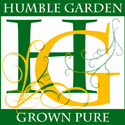
As part of my self-learning on permaculture, I have been walking out my back door and selecting a plant that catches my eye and then finding out everything I can about that plant. I will write here about some of the more interesting ones.
To identify plants and trees, I use google, twitter (especially with hashtags #horticulture #permaculture #botany #garden and similar relevant terms), and especially a certain flickr group called “ID Please” where people post images of an organism they would like to identify. Once they do this, others then give pretty educated guesses on identification.
I will add identified plants, mushrooms, trees, fauna, to my Humble Garden permaculture page at the link -> Permaculture.
Eric Toensmeier, co-author of Edible Forest Gardens (2 volume set), wrote about pokeweed in his book “Perennial Vegetables: From Artichokes to Zuiki Taro, A Gardener’s Guide to Over 100 Delicious and Easy to Grow Edibles
“.
On page 176 he explains that while the mature plant is quite poisonous, especially those parts with red coloring, people have been eating the young leaves for likely thousands of years.
Young shoots 6 – 8 inches long are harvested and then the dickens is boiled out of them (breaks down the poisons). The berries are an intense red color and look rather juicy.
Keep this plant away from kids, pets, and livestock as the mature form is not fit for fresh eating.

It seems that red is Mother Nature’s way of saying “Beware”.

My own observations:
This plant grows VERY fast and puts on a lot of biomass in one season. It is growing in a region that was greatly disturbed (was fill brought in to build up part of the landscape) and has been spreading somewhat every year. I have not noticed it growing in the much more mature and undisturbed forest adjacent to it so I am guessing it came with the fill or the top soil that was imported from a dairy farm (the top soil from the pasture of a local dairy farm that went bust, filled with cow bones!).
Use strategy:
As I have small children and loads of mischievous goats who do not speak english and even if they did, are so oppositional that they would eat the pokeweed if told not to, I plan on trying to suppress this plant as much as I can.
I know they have a tenacious root system and that they also spread by or are disbursed by birds who eat the berries.
I am going to analyze the surrounding vegetation to see if they can be considered beneficial. If yes then I might just yank the pokeweed and let those beneficials fill in. If not, then I am going to look at this “waste” area a bit more closely to see how I can use it better (ok, I am going to do that anyways but the pokeweed may be asking me to do this sooner than later).
Scientific Name:
Kingdom: Plantae
Division: Magnoliophyta
Class: Magnoliopsida
Order: Caryophyllales
Family: Phytolaccaceae
Genus: Phytolacca
Species: P. americana
Medicinal Uses: (sourced from the Wiki: SOURCE)
Physiologically, phytolacca acts upon the skin, the glandular structures, especially those of the buccal cavity, throat, sexual system, and very markedly upon the mammary glands. It further acts upon the fibrous and serous tissues, and mucous membranes of the digestive and urinary tracts. Phytolacca is alterative, anodyne, anti-inflammatory,antiviral, anti-cancer, expectorant, emetic, cathartic, narcotic, hypnotic,insecticide and purgative. (Phytolacca.—Phytolacca. | Henriette’s Herbal Homepage, http://www.swsbm.com/FelterMM/Felters-P.pdf)
Anti-cancer: The anticancer effects appear to work primarily based upon anti-tumor and anti-inflammatory properties, along with immune stimulant functions. Additional support for fighting cancer may come from antiplasmodial or cytotoxic fractions of the phytolacca toxin. And, although it has not been confirmed as a cause or factor of cancers, the antimicrobial, antiviral and antithelmetic properties of certain constituents might also play a part in anticancer activity. Further there are aromatase inhibitors and antioxidant properties that may affect cancer. Anti-cancer, antileukemic or anti-tumor constituents include: ascorbic acid, astragalin, beta carotene, caryophylline, isoquercitin, oleanolic acid, riboflavin, tannin and thiamine. Of the constituents known to fight cancer, oleanolic acid appears to be the most significant with its anticarcinomic; anticomplement, antihepatotoxic; antiinflammatory, antileukemic; antileukotriene, antinephritic, antioxidant, antiperoxidant , antiPGE2, antiplasmodial, antisarcomic; antiseptic, antiTGFbeta, antitumor (Breast, Colon, Kidney, Lung, Pancreas); antiviral, aromataseinhibitor; cancer-preventive; hepatoprotective; immunomodulator;leucocytogenic; NF-kB-Inhibitor; phagocytotic; and prostaglandin-synthesisinhibitor properties (Jeong SI, et al, Phytolacca americana inhibits the high glucose-induced mesangial proliferation via suppressing extracellular matrix accumulation and TGF-beta production, Phytomedicine. 2004 Feb;11(2-3):175-81)
Anti-inflammatory constituents include saponins in poke root and triterpenes in the berries: alpha spinasterol, ascorbic acid, calcium oxalate, caryophylline, isoquercitin, jialigonic acid, and oleanolic acid.
Immune stimulant constituents include astragalin, ascorbic acid, beta carotene, phosphorus and oleanolic acid.
Anti-AIDS: Pokeweed antiviral protein (a Single Chain Ribosome Inactivating Protein or SCRIP) is being considered as a potent inhibitor of human immunodeficiency for AIDS There are also well-known three different pokeweed antiviral protein (PAP)isoforms from leaves of Phytolacca Americana (PAP-I from spring leaves, PAPII from early summer leaves, and PAP-III from late summer leaves) that cause concentration-dependent depurination of genomic HIV-1 RNA.[1][15] (Phytolacca americana – Plants For A Future database report, Bodger MP, McGiven AR, Fitzgerald PH, Mitogenic proteins of pokeweed. I. Purification, characterization and mitogenic activity of two proteins from pokeweed (Phytolacca octandra), Immunology. 1979 Aug;37(4):785-92)
Antiviral: PAP, oleanolic acid, ascorbic acid, tannin, mitogen.
In addition: Betanin and oleanolic acid are antiperoxidative and the vitamins plus caryophylline and oleanolic acid are antioxidant. Astragalin, isoquercitin and caryophylline are aldose-reductase-inhibitors.
Clearly pokeweed has an impressive diversity of bioactive compounds on-board. Its strong medicine and an advanced topic!


































